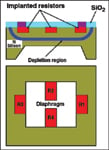Micron-scale fabrication techniques fostered by the semiconductor and IC industries have produced an enormous variety of sensing devices that are both smaller and smarter than their precursors. Microelectromechanical systems (MEMS), as these devices are called, have become common in the past 20 years [1-3]. For example, the accelerometers and gyroscopes designed for automotive applications are now nearly universally configured as MEMS [4]. The technology is becoming ubiquitous in areas as diverse as consumer electronics (optical projection) [5], communications (optical multiplexing) [6], surface analysis (scanning tunneling microscopy) [7], and biotechnology (DNA amplification and identification) [8].
Gas flow, temperature, and pressure, as well as a variety of special properties, are routinely measured with solid-state MEMS devices [1]. Vacuum sensing has followed this trend [9], with both the sensing element and its associated electronics miniaturized to the point where multiple sensing functionalities, along with control and signal conditioning electronics, can be integrated into a single device.
The MicroPirani
Pirani gauges have been widely used for vacuum measurement since their invention in 1906 [10]. A heated wire with a high temperature coefficient of resistance is placed in a vacuum environment. The wire, whose resistance is proportional to its temperature, forms one leg of a balanced Wheatstone bridge. Gas molecules collide with the wire, transferring heat away from it and unbalancing the bridge relative to a reference state. Since the frequency of molecular collisions is proportional to the gas pressure, the voltage required to maintain the bridge in balance is proportional to the pressure. Pirani gauges have become an industry standard, owing to their reliability, low cost, and relatively wide pressure range [11].
Conventional Pirani gauges have certain drawbacks, though. In the large older gauges, the element's high temperature (~100°C to 150°C above ambient) presents a problem in process environments where the gases are thermally reactive. Reaction products can coat the wire element and modify its resistive response to pressure changes. The sensing mechanism is affected by other factors as well. Heat dissipation within the gauge occurs via heat transfer from the heated element to the ambient gas, followed by heat transfer between the gas and the cool instrument wall. This works well at relatively low pressures because the mean free path of the gas molecules in the system is greater than the element-to-wall distance. At higher pressures, however, the mean free path is reduced to values significantly less than this distance; nonlinearities enter into the pressure-voltage relationship and reduce the gauge's sensitivity. For conventional Pirani gauges to operate at pressures up to 760 torr, they must be constructed with wire-to-wall distances great enough to allow heat transfer to occur by convective flow at higher pressures. Unfortunately, this convective flow introduces sensitivity to the mounting position because gravity affects convective currents within the gauge. A difference in mounting position thus results in a difference in the electrical output–pressure relationship. The heat transfer mechanism in Pirani transducers also makes them sensitive to differences in ambient temperature since these cause variations in the instrument wall temperature. In the conventional Pirani gauge, the wire is thermally anchored at two points, causing pressure-dependent temperature gradients at the end of the wire [12]. Finally, the heat transfer mechanism dictates that gauge response will depend on the composition of the gas being measured, since the heat capacity of the gas affects heat transfer.
 Figure 1. The MKS MicroPirani vacuum gauge solves many of the performance problems associated with conventional Pirani gauges—and has a much smaller footprint as well. |
MKS Instruments Inc. recently introduced the MKS 925C MicroPirani sensor (see Figure 1) with a range of 10–5 torr to atmosphere. This thermal conductivity sensor takes advantage of MEMS technology to solve these problems. The sensing element is made of a thin-film nickel resistive element deposited onto a silicon substrate (see Figure 2). Another silicon substrate forms a small cavity on top of the resistors. The microscale wire-to-wall distance eliminates convective flow as a heat transfer mechanism within the sensor, permitting only diffusive gas flow. The small geometry of the sensing head dramatically reduces the active volume of the sensor head, and this is crucial to improving performance. The lack of dependence on convective flow makes the 925C insensitive to mounting position. The greatly reduced head volume means a smaller thermal mass for the sensor and much less gas to be heated for the sensing process. The benefits are a significantly faster response time (see Figure 3) and a filament temperature only 35°C above ambient, as compared with 100°C–150°C for conventional gauges. Lowering the element temperature results in a significantly longer sensor lifetime and makes the sensor much less sensitive to contamination caused by gas cracking and deposition or corrosion on the element. Finally, the small geometry and mass of the solid-state MicroPirani sensor allow it to withstand vibratory forces up to 900 g's.
 Figure 2. The MicroPiranis sensor chip is made of a thin-film nickel resistive element deposited onto a silicon substrate (A). Another silicon substrate forms a small cavity on top of the resistors (B). |
The 10–5 torr-to-atmosphere measurement range is two decades wider than can be achieved by conventional convection gauges. Integrating the sensor and its control and compensation circuitry on a single chip eliminates the need to pass low-power, sensitive signals over long distances between the gauge and the controller. The active circuitry in the sensor allows a simple pressure-related signal to be transferred between sensor and controller, significantly reducing connection and implementation costs. The 925C has one set-point relay, RS-232 or RS-485 communications, and an analog output of 1 VDC/decade, allowing the unit to be easily incorporated into a wide variety of manufacturing applications.
 Figure 3. In this graphical representation of the 925C MicroPiranis pressure response time, note that as the conventional Pirani gauge approaches its detection limit, its speed of response worsens significantly. The MicroPirani measures to 1 3 10–5 torr and therefore retains a fast response through the 10–3 and 10–4 decades of pressure measurement. |
One of these is computer-controlled vacuum sensing in semiconductor fabrication. Although the gas dependence of MicroPirani gauges limits their use in the process chambers, the small footprint and simplified connectors make them well suited for pressure measurement in the manufacturing equipment's forelines and load-lock chambers. Moreover, the gauges' fast response is of particular advantage because load-locks must be pumped to high vacuum at speeds that can overwhelm conventional convection Pirani devices.
The MicroPirani could also replace the multiple sensors and associated support electronics currently used for rough vacuum measurement in analytical instruments such as electron microscopes and mass spectrometers.
Combination Gauges for Wide-Range Measurements
MEMS piezoresistive pressure sensors can be used in many applications that require gas-independent measurements in the 10–1 to 1000 torr pressure range [13]. Combining these sensors with MicroPirani and miniaturized ionization gauge technology yields a single, compact detector capable of performing several different vacuum measurement functionalities. The advantages include a reduction in wiring complexity, control electronics, and real estate on the vacuum tool.
 Figure 4. The Quattros piezoresistive sensor transforms mechanical stress due to pressure into an electrical signal. |
The MKS 999 Quattro gauge incorporates essentially all of the vacuum sensing technology needed for advanced vacuum tools. A MEMS-based MicroPirani, piezoresistive differential and absolute sensing elements, miniaturized hot cathode technology, and an atmospheric pressure switch are integrated into this device. Figure 4 shows a cross-sectional schematic of the piezoresistive sensor used in the Quattro. This element transforms mechanical stress due to pressure into an electrical signal and has a range of 0.1 to 1000 torr. The pressure measurement is independent of the gas composition and has a fast response (see Figure 5). The presence of these different functionalities, coupled with intelligent circuitry to smoothly transition between sensors, gives the Quattro a continuous measurement range from 5 × 10–10 to 1000 torr. Accuracies are between 1% and 15%, depending on the measurement range. The gauge can be operated via digital communications that enable the full functionality of the unit, or as an autonomous analog unit providing pressure and three independent relays.
 Figure 5. The Quattro combination vacuum transducers response time is much faster than a conventional Pirani gauge at high pressures, and also more accurate as it approaches atmospheric pressure. In fact, the Quattros response is virtually identical to that of a Baratron, considered the industry standard. (The test data in this graph were collected in Boulder, CO, where atmosphere is at 638 torr rather than the 760 torr at sea level.) |
Summary
MEMS-based vacuum measurement technologies offer significant advantages over conventional vacuum gauges. These transducers are much more robust, offer wider measurement ranges and faster response times, and have greatly reduced footprint and connection requirements. The solid-state construction results in a transducer with higher performance and repeatability than is possible with conventional approaches. The signal conditioning achieved through the integration of MEMS devices and onboard electronics greatly simplifies digital user interfaces and allows these transducers to be very easily incorporated into equipment/process control schemes.
References
1. Tai-Ran Hsu, MEMS and Microsystems. New York: McGraw Hill, 2002.
2. M. Esashi, "Silicon Micromachining for Integrated Microsystems," Vacuum, Vol. 47, 1996, p. 469.
3. M. Esashi et al., "Vacuum-Sealed Silicon Micromachined Pressure Sensors," Proc IEEE, Vol. 86, 1998.
4. J. Bernstein, "An Overview of MEMS Inertial Sensing Technology," Sensors, Feb. 2003.
5. D.M. Bloom, "The Grating Light Valve: revolutionizing display technology," Proc SPIE, 1998, p. 3013.
6. K. Kwon, "A Micromachined 232 Optical Switch Aligned With Bevel-Ended Fibers for Low Return Loss," J Microelectromechanical Systems, Vol. 13, 2004, p. 258.
7. M.A. Poggi et al., "Scanning Probe Microscopy," Anal Chem, Vol. 76, 2004, p. 3429.
8. A.C. Richards Grayson et al., "A BioMEMS Review: MEMS Technology for Physiologically Integrated Devices," Proc IEEE, Vol. 92, No. 6, 2004.
9. S. Wilfert and C. Edelmann, "Miniaturized Vacuum Gauges," J Vac Sci Technol A, Vol. 22, 2004, p. 309.
10. M. Pirani, Verh Dtsch Phys Ges, Vol. 8, 1906, p. 686.
11. W.J. Alvesteffer et al., "Miniaturized Thin Film Vacuum Sensor," J Vac Sci Technol A, Vol. 13, 1995, p. 2980.
12. W. Jiatschin and M. Ruschitzka, "Metrological properties of the thermal conductivity gauge," Vacuum, Vol. 44, 1993, p. 607.
13. P. Adrien, "MKS Enlarges Opportunities in Vacuum Sensing," Sensor Business Digest, June 2003, excerpted in Sensors Online, www.sensorsmag.com/resources/businessdigest/sbd0603.shtml.
Paul Dozoretz is Engineering Manager; Chris Stone is Product Manager, HPS Vacuum Gauges; and Ole Wenzel is Managing Director, MKS Denmark.
For more information, contact Paul Dozoretz or Chris Stone, MKS Instruments Inc., Boulder, CO; 303-449-9861, [email protected], [email protected], www.mksinst.com.
